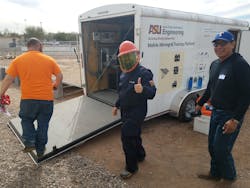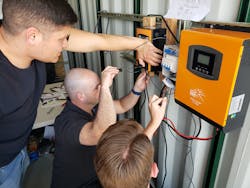Energy Storage and Microgrid Training for Electricians Takes Off
Surging interest in distributed electricity generation is starting to highlight the importance of ensuring safe and competent design and installation of the energy storage and microgrid (ESM) systems that make it possible.
The latest evidence comes from California, where a state program to build a workforce for a carbon-neutral future will include funding for bringing dedicated ESM installation training to a limited number of licensed electricians over time. The California Workforce Development Board (CWDB) allocated $1.25 million to fund the training, which will utilize a comprehensive curriculum developed over the last several years through Penn State University: the Energy Storage and Microgrid Training and Certification (ESAMTAC) program (see ESAMTAC Training at a Glance below for more details). Supported by industry groups and the National Science Foundation, ESAMTAC is geared to developing a network of contractors capable of building ESM projects safely and ensuring that they perform reliably afterward.
ESM safety and installation expertise development in this area has been drawing the attention of other training and consulting entities, too. Protogen, a distributed energy consulting company, was planning to hold a safety-oriented energy storage symposium last year, but it was cancelled due to COVID-19. Arizona State University’s Laboratory for Energy Solutions offers a microgrid boot camp and master classes that have ESM workforce competency development as a central mission.
The new California initiative would produce the first broad-based orchestrated rollout of ESAMTAC, which has been deployed on an on-demand basis as a network of educators has been built up and slowly connected with interested training organizations around the United States. In the west, ESAMTAC is taught at a number of training sites, including two large training schools — the Electrical Apprenticeship Training Center of Southern Nevada in Las Vegas and the Electrical Training Institute of Southern California in Commerce, Calif.
Bernie Kotlier, executive director of the Labor Management Cooperation Committee for IBEW-NECA California & Nevada, which was the formal applicant for the CWDB grant and will serve as a facilitator, says several hundred California electricians annually could complete the 40-hour ESAMTAC program over the next few years, ultimately increasing the margin of safety and reliability of future ESM projects in the state, which are likely to increase in number.
"The primary benefit of this program will not necessarily be expanding the number of projects that are done in California, since that’s been moving ahead strongly, but instead it’s more about how they’ll be constructed,” Kotlier says. “Energy storage and lithium ion batteries that are not installed and maintained properly can pose numerous safety issues that need to be addressed through a chain of electrician training, testing, and certification. As more of these projects are built, we need to be as certain as we can be that they’re done right.”
ESM safety awareness has been elevated with recent updates to codes, including NFPA 855, which addresses installation standards for stationary energy storage systems, and UL 9540A, which addresses a test method for safety hazards associated with propagating thermal runaway with battery systems. For additional information, read “Seeking Smarter and Safer Storage.”
Companies engaged in designing and building microgrids are emphasizing the importance of focusing on competent and safe installations, too. S & C Electric Company, Chicago, argues that energy storage for microgrids demands thorough review and analysis because “getting it wrong is an expensive and dangerous mistake.” It speaks from experience, as lithium battery production at one of its facilities produced a fire in 2016. Read “Lessons Learned From Our Fire in Franklin” for more information. To help understand the complexity of energy storage, watch the short video from S&C on how to predict and mitigate challenges.
SIDEBAR: ESAMTAC Training at a Glance
Energy Storage and Microgrid Training and Certification (ESAMTAC) is provided through two courses, each consisting of lecture, lab activities, and a corresponding credential issued by ESAMTAC.
Prerequisite: A working knowledge of electrical construction, including safety codes and standards. How to safely and productively handle, assemble, and interconnect microgrid system components. Special emphasis is placed on the construction of large stationary battery systems.
COURSE
The ESAMTAC course develops knowledge and skills with an emphasis on energy storage and microgrid components. The course includes instruction, testing, and credentialing based on skills attainment. Course work includes a robust overview of energy storage and microgrid (ESM) systems and hands-on activities to reinforce classroom instruction.
PRIMARY MODULES
- Business drivers of ESM systems
- Microgrid systems & components (generation)
- Energy storage systems and components
- Safety of ESM
- DC power systems (DC theory)
- ESM assembly & method of procedure
- ESM system arc flash & shock protection
- Battery enclosure & rack components & requirements
- Installation of batteries into racks and enclosures
- Connections between batteries
- DC power conductors and connections
- Grounding & bonding of ESM systems
- DC control conductors and connections
- Situational assessment of installed ESM systems
Zind is a freelance writer based in Lees Summit, Mo. He can be reached at [email protected].






